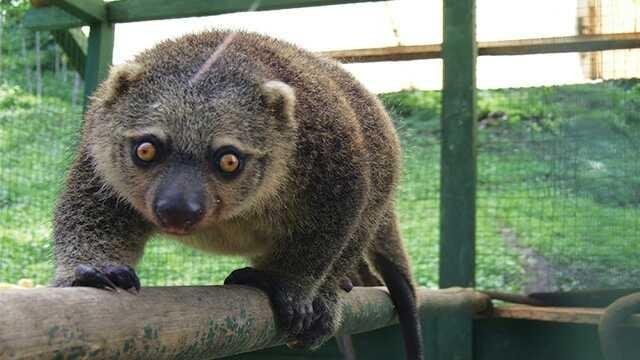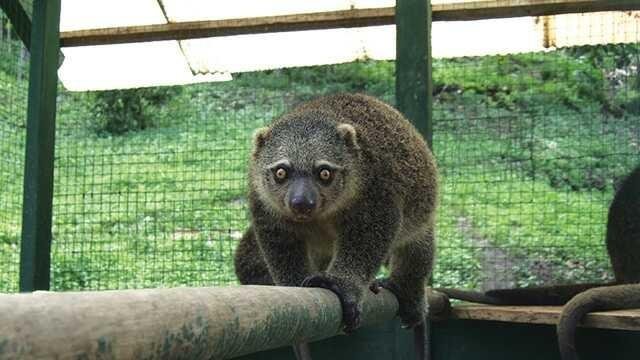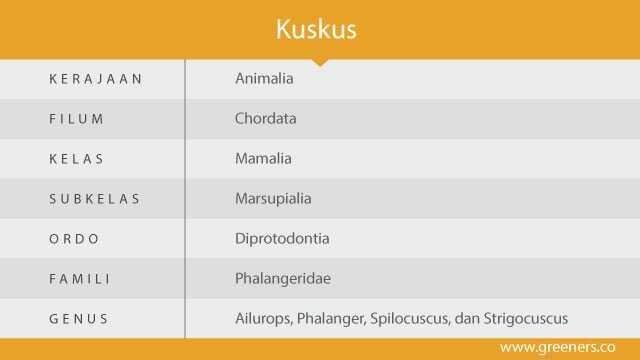
Animals that move slowly and have a funny look are very easy to be coveted by animal hunters, for example just like the animal slow loris Java (Nycticebus javanicus). Similar threats also occur in cuscus animals.
Cuscus is endemic marsupial (marsupialia). Based on several sources, the distribution of cuscus spread throughout much of eastern Indonesia. These marsupials belong to the Phalangeridae family. According to experts, this animal is described large and sturdy, and also has a two-month-long pigs. The genus belonging to the species of cuscus is Ailurops, Phalanger, Spilocuscus, and Strigocuscus. Their fur coloring patterns were differentiated in two genera, namely Spilocuscus and Phalanger genus, each of which consisted of 3 to 8 types.
In Papua there are two types of cuscus, the spotted cuscus (Spilocuscus) and the spotted couscous (Phalanger). One type of cuscus that is endemic papua is Spilocuscus papuensis and Spilocuscus rufoniger. While in the Sulawesi archipelago there are three types of endemic kuskus namely Ailurops ursinus, Phalanger pelengensis and Strigocuscus celebensis.
The Maluku Islands are also home to several endemic kuskus namely Phalanger ornatus, Phalanger rothschildi, Phalanger sp. and Spilocuscus sp. In addition to Indonesia, cuscus can also be found in New Guinea and parts of Australia.
Cuscus has a long, powerful tail that can help it when climbing trees. His eyes are round, small ears, have similar fur with different colors according to their respective genus into the uniqueness apart from these marsupialia animals. In the female there is a bag as a place menggendongosis.

Cuscus habitat is located in the primary forest area that has not been disturbed by the lush tree species. They usually do activities at night (nocturnal) and rest during the day on the trees. How to sleep was very funny, sometimes kuskus rest by bending and hugging a tree trunk in the condition of the canopy lush or open (quoted from portal biovasi09unipa.blogspot.co.id). Cuscus also often consume various types of food such as vegetables, fruits, corn and other foods that contain lots of fiber.
Cuscus populations are declining due to the threat of deforestation and much hunted. Through IUCN data, rare marsupialia from Indonesia is categorized as Endangered Species, in CITES classified Appendix II. The factors behind the illegal hunting conducted by the local community, among other elements of culture, consumption, illegally traded, maintained, taken leather as a bag material and made ornaments.
Cuscus in Indonesia itself has been protected since 1990 through the Regulation of Wild Animals Hunt (PPBL) no. 226/1931, Law no. 5/1990 on the Conservation of Biological Natural Resources and its Ecosystem, and Law no. 7/1999 on the Preservation of Plant and Animal Species.
Continuous cuscus hunting is ensured to cause a decrease in the number of populations and even reach extinction rates. A case study in Lumoli Village, West Seram District, Maluku, based on information from local communities indicates that cuscus is still being hunted by the community for meat consumption and hair removal (quoted from Usmany et al., Patimura University in the journal Sain Veteriner, 2015).
The forest is a haven for the life of the kuskus, where the forests are a breeding ground, resting and looking for food. It is unfortunate that endless deforestation activities force them to change their ecological and biological clock conditions. This activity is feared will threaten their survival, even kuskus extinction.
Deforestation and illegal hunting have a very close relationship, it is fitting that this should not be underestimated by all parties and circles. Who else will tell the uniqueness of Indonesia's unique animals to our children and grandchildren in the future if the animal alone must be extinct not because it is eaten by time but because of human greed.
